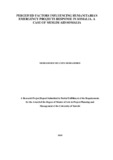| dc.description.abstract | The purpose of this study was to investigate the perceived factors that influence humanitarian emergency Projects’ response in Somalia. Since the Second World War, the number of humanitarian emergencies has continued to rise steadily around the world. Global scale humanitarian organizations like the United Nations and international committee of the Red Cross were set up to assist humanity during times of calamities. In Africa, Disaster risks such as extreme depletion of water resources, rapid and unplanned urbanization, global climate change, and environmental degradation, among other reasons, are expected to create more frequent and severe disasters in the near future and thus calls for more humanitarian assistance. Somalia having witnessed decades of civil strife and violence has not been left out in the face of calamity. The strife in Somalia has further been fueled by lack of government stability, harsh climatic conditions and terrorism. The purpose of the study therefore was to investigate the perceived factors influencing humanitarian emergency projects response in Somalia. The objectives of the study were to determine how effective communication influences humanitarian emergency projects’ response, to establish how community involvement and participation influences humanitarian emergency projects’ response, to examine how coordination with central government influences humanitarian emergency projects response, to assess the extent to which management of aid resources influences humanitarian emergency response. This study adopted a descriptive survey research design. The number of beneficiaries in Somalia through Muslim Aid by the end of 2017 was over 20,000 with 554 based in urban area and the number of staffs was 117. A sample of 42 staff members was drawn, each with two respondents and a sample of 202 beneficiaries. The study administered questionnaires to Muslim Aid Somalia head office and field employees within Somalia. The study employed both primary and secondary data. Primary data was collected using questionnaires. The questionnaires had both open-ended and closed questions. The open-ended questions enabled the researcher to collect qualitative data. This was used in order to gain a better understanding and possibly enable a better and more insightful interpretation of the results from the study. The descriptive statistical tools helped the researcher to describe the data and determine the extent used. Analysis was done quantitatively and qualitatively by use of descriptive statistics. The main tool for data analysis was SPSS (statistics package of social science) and Microsoft excels percentages, tabulations, means and other central tendencies. Tables were used to summarize responses for further analysis and facilitate comparison. This generated quantitative reports through tabulations, percentages, and measures of central tendency. The study found that language barrier greatly affects humanitarian emergency projects response followed by more feedback. The study established that cooperation in decision making greatly affect humanitarian emergency projects response followed by numbers of members involved. The study indicated that government collaboration greatly affects humanitarian emergency projects response and that funding by government affect humanitarian emergency projects response. The study recommends that there is need to increase training and awareness on humanitarian emergency projects’ response processes and procedures through formal training and in-service training to keep them updated in the field. The Humanitarian emergency projects’ response activities should be allocated enough resources and facilities so as to enhance implementation. There is need to implement the existing humanitarian emergency projects’ response framework in carrying out activities so as to align various activities to standard protocols which many county governments have failed to adhere to. | en_US |



